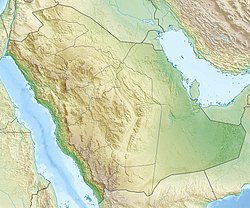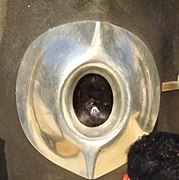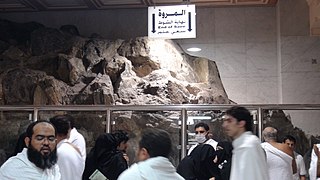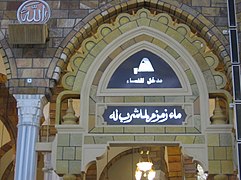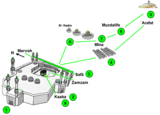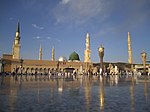
Mecca is the capital of Mecca Province in the Hejaz region of western Saudi Arabia and the holiest city according to Islam. It is 70 km (43 mi) inland from Jeddah on the Red Sea, in a narrow valley 277 m (909 ft) above sea level. Its last recorded population was 2,385,509 in 2022. Its metropolitan population in 2022 was 2.4 million, making it the third-most populated city in Saudi Arabia after Riyadh and Jeddah. Around 44.5% of the population are Saudi citizens and around 55.5% are foreigners from other Muslim countries. Pilgrims more than triple the population number every year during the Ḥajj pilgrimage, observed in the twelfth Hijri month of Dhūl-Ḥijjah. With over 10.8 million international visitors in 2023, Mecca was one of the ten most visited cities in the world.
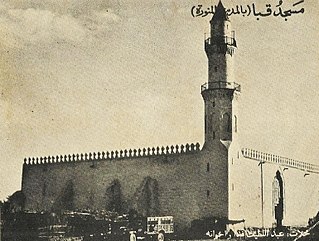
The Quba Mosque is a mosque located in Medina, in the Hejaz region of Saudi Arabia, built in the lifetime of the Islamic prophet Muhammad in the 7th century C.E. It is thought to be the first mosque in the world, built on the first day of Muhammad's emigration to Medina. Its first stone is said to have been laid by the prophet, and the structure completed by his companions.

Safa and Marwa are two small hills, connected to the larger Abu Qubais and Qaiqan mountains, respectively, in Mecca, Saudi Arabia, now made part of Al-Masjid al-Haram. Muslims travel back and forth between them seven times in what is known as saʿī ritual pilgrimages of Ḥajj and Umrah.
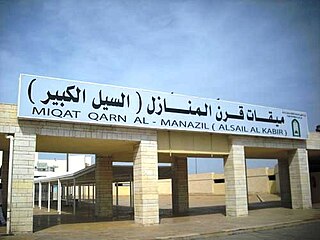
The miqat is a principal boundary at which Muslim pilgrims intending to perform the Ḥajj or ʿUmrah must enter the state of iḥrām, a state of consecration in which certain permitted activities are made prohibited.

The holiest sites in Islam are predominantly located in the Arabian Peninsula and the Levant. While the significance of most places typically varies depending on the Islamic sect, there is a consensus across all mainstream branches of the religion that affirms three cities as having the highest degree of holiness, in descending order: Mecca, Medina, and Jerusalem. Mecca's Al-Masjid al-Haram, Al-Masjid an-Nabawi in Medina and Al-Masjid al-Aqsa in Jerusalem are all revered by Muslims as sites of great importance.

Ali Ahmed Mullah, is the veteran muazzin at the Masjid al-Haram in Mecca, Saudi Arabia for the past three decades. Ali Ahmed Mulla is the longest serving muazzin for the Masjid al-Haram and has been following his family tradition in this profession since 1975.

The destruction of heritage sites associated with early Islam is an ongoing phenomenon that has occurred mainly in the Hejaz region of western Saudi Arabia, particularly around the two holiest cities of Islam, Mecca and Medina. The demolition has focused on mosques, burial sites, homes and historical locations associated with the Islamic prophet Muhammad, his companions, and many of the founding personalities of early Islamic history by the Saudi government. In Saudi Arabia, many of the demolitions have officially been part of the continued expansion of the Masjid al-Haram at Mecca and the Prophet's Mosque in Medina and their auxiliary service facilities in order to accommodate the ever-increasing number of Muslims performing the pilgrimage (hajj).

The Kaaba, sometimes referred to as al-Ka'ba al-Musharrafa, is a stone building at the center of Islam's most important mosque and holiest site, the Masjid al-Haram in Mecca, Saudi Arabia. It is considered by Muslims to be the Bayt Allah and is the qibla for Muslims around the world. The current structure was built after the original building was damaged by fire during the siege of Mecca by Umayyads in 683 AD.

Both Sunni Muslims and Shia Muslims agree on the three holiest sites in Islam being, respectively, the Masjid al-Haram, in Mecca; the Al-Masjid an-Nabawi, in Medina; and the Al-Masjid al-Aqsa, in Jerusalem.

Both Sunni Muslims and Shia Muslims agree on the three Holiest sites in Islam being, respectively, the Masjid al-Haram, in Mecca; the Al-Masjid an-Nabawi, in Medina; and Al-Masjid al-Aqsa, in Jerusalem.

Hajj is an annual Islamic pilgrimage to Mecca, Saudi Arabia, the holiest city for Muslims. Hajj is a mandatory religious duty for Muslims that must be carried out at least once in their lifetime by all adult Muslims who are physically and financially capable of undertaking the journey, and of supporting their family during their absence from home.

Masjid Al-Taneem is a mosque in the area of Al-Hil, about 5 miles away from the Kaaba, in the neighbourhood of At-Tan'im in Makkah, western Saudi Arabia. It is a boundary of the Ḥaram, therefore pilgrims of Ḥajj and ʿUmrah can put on Iḥram. This mosque is also known as Masjid Aishah, since Aisha bint Abu Bakr, wife of the Islamic prophet Muhammad, had put on her Ihram from this place once.
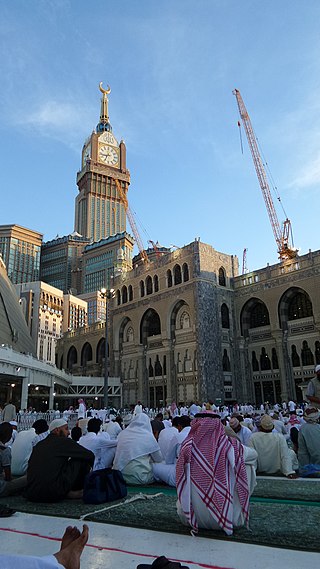
Abu Qubays is a sacred mountain which resides on the eastern frontier of Al-Masjid Al-Haram in Mecca, in the Hejaz region of Saudi Arabia.

Abdullah Awad Al Juhany, is one of the nine Imams of the Grand Mosque Masjid al-Haram in Mecca. He holds a B.A. from the faculty of Qur'an at the Islamic University of Madinah, and a doctorate (Ph.D.) from Umm al-Qura University in Mecca.
The following is a timeline of the history of the city of Mecca, Saudi Arabia.

The Khalili Collection of the Hajj and the Arts of Pilgrimage is a private collection of around 5,000 items relating to the Hajj, the pilgrimage to the holy city of Mecca which is a religious duty in Islam. It is one of eight collections assembled, conserved, published and exhibited by the British-Iranian scholar, collector and philanthropist Nasser Khalili; each collection is considered among the most important in its field. The collection's 300 textiles include embroidered curtains from the Kaaba, the Station of Abraham, the Mosque of the Prophet Muhammad and other holy sites, as well as textiles that would have formed part of pilgrimage caravans from Egypt or Syria. It also has illuminated manuscripts depicting the practice and folklore of the Hajj as well as photographs, art pieces, and commemorative objects relating to the Hajj and the holy sites of Mecca and Medina.

Muhammad Sadiq Bey was an Ottoman Egyptian army engineer and surveyor who served as treasurer of the Hajj pilgrim caravan. As a photographer and author, he documented the holy sites of Islam at Mecca and Medina, taking the first ever photographs in what is now Saudi Arabia.
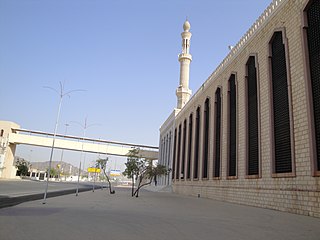
Masjid an-Namirah or Masjid Nimrah is a mosque in Wadi Uranah near Mecca in the Hejazi region of Saudi Arabia. It is believed to be where the Islamic prophet Muhammad stayed before delivering his last sermon in 'Arafat. It is one of the most important landmarks during the Hajj, as it is where the khutbahs are delivered to pilgrims during the Day of Arafah during the Dhuhr and Asr prayers. It is located near Mount Arafat.


